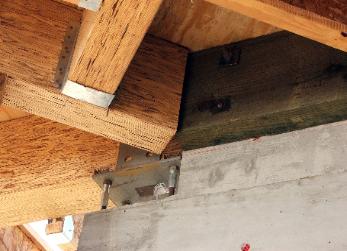


LVL, LSL and PSL
TJ (Trus Joist) International, Inc., is the world's leading
manufacturer of engineered lumber products. Having
pioneered this field in the 1960s, TJ continues to hold a 60
percent share of the North American market
As the supply of old growth trees needed for solid-sawn
lumber dwindles, Trus Joist's products offer alternatives
that are not only more readily available and more
environmentally friendly, but also stronger, more reliable,
and less labor intensive.
TJ (Trus Joist) International, Inc., is the world's leading
manufacturer of engineered lumber products. Having
pioneered this field in the 1960s, TJ continues to hold a 60
percent share of the North American market
As the supply of old growth trees needed for solid-sawn
lumber dwindles, Trus Joist's products offer alternatives
that are not only more readily available and more
environmentally friendly, but also stronger, more reliable,
and less labor intensive.


- Marketed under the Microlam trademark TJ pioneered the laminated veneer lumber (LVL) market, in
which logs are cut into thin sheets of veneer, which are then dried, graded, and layered together with
the grain parallel. This configuration is then processed using adhesives, heat, and pressure to create
wood struts with thicknesses of three-quarters of an inch to 3.5 inches, widths from 24 to 48 inches,
and lengths of up to 80 feet. The LVL process eliminates the natural defects of wood, such as knots
and warping, reducing wastage. The LVL process is also capable of using up to 75 percent of a log. In
addition, the struts are manufactured with knockout holes for wiring and piping, reducing
construction site labor costs.
- Under the Parallam trademark, TJ markets its parallel strand lumber (PSL) products. Similar to LVL, PSL
clips the veneer sheets taken from a log into 5/8" wide strands up to eight feet long. The strands are
coated with adhesives, then subjected to pressure and microwave heating to cure the adhesives. The
resulting billet, or block of lumber, can reach measurements up to 11 inches by 20 inches by 66 feet.
The PSL process, which remains closely protected by patents, is capable of using a higher percentage
of a log than traditional lumber techniques or LVL.
- Trus Joist's youngest product line, marketed under the TimberStrand trademark, uses a proprietary
technology called laminated strand lumber (LSL). Unlike LVL and PSL, which typically use logs from
larger trees such as pines, LSL uses small, cheaper, and faster-growing aspen, yellow poplars, and
other species typically used as pulp logs. In the PSL process, logs are flaked into 12-inch-long
strands, which are then coated with adhesives and pressed using steam-injection, which cures the
adhesive and adds density to the wood. LSL boards range up to 5.5 inches thick, eight feet wide, and
48 feet long.
All three variations offer several advantages over typical milled lumber: the beams are stronger, straighter,
and more uniform. They are much less likely than conventional lumber to warp, twist, bow, or shrink.